Menus
- The easy missile
- Euro5, 4 cylinders 998 cm3, 200 hp and 113.3 Nm, 201 kg full made, from € 19,299
- Discovery
- Electronic
- YZF-R1 M version
- In the saddle
- On track
- Conclusion
The easy missile
Euro5, 4 cylinders 998 cm3, 200 hp and 113.3 Nm, 201 kg full made, from € 19,299
Each brand has its legendary hyper-sport, its technological showcase, its fighter plane. Yamaha has had its circuit muse for more than 20 years: the YZF-R1. This model appeared in 1998 and already stood out with its revolutionary three-axis engine. Crankshaft, primary shaft and secondary shaft are not aligned on a horizontal plane, but arranged in a triangle so as to reduce the length of the engine as much as possible. It delivers 150 hp for 177kg dry.
The 2004 generation is completely new and offers, for the very first time on a production motorcycle, a power to weight ratio of 1 to 1 with 172 hp and 172 kg dry. The maximum speed increases to 12,500 rpm, ie 2,000 revolutions more than on the previous version. After ten years of existence, the R1 sets its new mechanical signature in 2009: "Crossplane" technology. It is characterized by its crankshaft crankshaft crankshaft setting at 90 °, optimizing power and torque over the entire available speed range..
Seventeen years after the introduction of the YZF-R1, the 2015 model is an all-new machine with technologies inherited from MotoGP’s YZR-M1. Its engine incorporates a new Crossplane crankshaft (titanium fractured-headed connecting rods (40% lighter than steel) .It is also the invasion of an armada of chips controlled by a 6-axis inertial sensor (IMU) that comes standard on the motorcycle.
After a new evolution in 2018, the R1 is still sublime for 2020. The hypersport is now offered a retouched design, an optimized engine and suspension and seven electronic controls always more precise. And since only the best is enough, it always accompanies its transformation with an ultimate version, the R1-M.
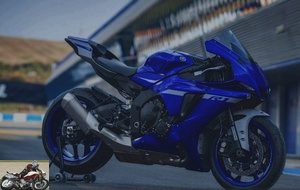 Yamaha YZF-R1 2020
Yamaha YZF-R1 2020
To get an idea of the new Yamaha, we take them at a good pace on the circuit of Jerez de la Frontera (Spain), where their dynamic capacities should be able to express themselves without difficulty..
Discovery
Original, attractive, the design of the YZF-R1 imposes since 2015 its elegant minimalism against the aggressive style usually used in the segment. Mimicking MotoGP machines to perfection, its lines almost mask the presence of the headlights. From all sides, the machine evokes racing, performance and a certain and astonishing stealth. Aerodynamics should improve by 5%. However, the new vintage does not cause a "Wow" over-effect. Fluid, hyper-compact, the R1 would be almost discreet. Whatever Yamaha says, the aesthetic changes very little, raising the bubble a little and slightly opening the latest generation LED lights. However, there is a wider front face, now traversed by two ribs framing the front air intake to point in hooks. Just enough to play the game of mistakes.
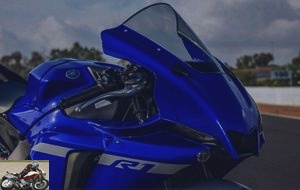 Yamaha YZF-R1 fairing
Yamaha YZF-R1 fairing
Strong indentations at the knees, the sides of the 17-liter tank leave plenty of room for the pilot to move around. A recess at its top awaits your helmet to limit the pressure at high speeds…. The pilot seat seems to leave the necessary space for this dab position. It is based on a much more ostentatious magnesium rear loop. Solid in the lower part, the frame spars are then refined into two sheets forming fins then sheathed in plastic, creating a sharp stern. A blade of diodes clings vertically to the whole and the whole produces a rather remarkable dynamic effect. Less visible, the forced air line changes to aluminum (plastic front) and the catalyst protection plate changes to titanium.
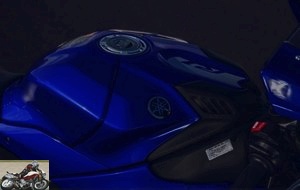 Yamaha YZF-R1 tank
Yamaha YZF-R1 tank
Overall, the finish is excellent. The fit of the elements, the quality of the components and the coating of the majority of the metal surfaces are beyond reproach. And the materials are the finest. Thus, magnesium is used in most crankcases (cylinder head cover, clutch, starter, low engine) and one-piece rims. Titanium boosts the mechanics and the escapement.
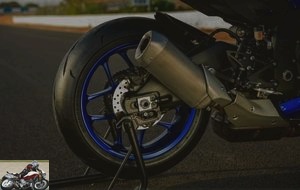 Muffler of the Yamaha YZF-R1
Muffler of the Yamaha YZF-R1
Everything is based on a Deltabox aluminum frame, dear to Yamaha, integrating the engine as a supporting element. We find there, almost unchanged, the 4 cylinders with double overhead camshafts and four valves per cylinder of 998 cm3 (79×50.9 mm). Its cross plane crankshaft offers an irregular ignition sequence of 270 ° – 180 ° – 90 ° – 180 °. The interest is to linearize the variations in engine torque due to variations in piston speed. And that gives it a seductive character and sound, close to that of a V4. The block still delivers 200 hp at 13,500 rpm and 113.3 Nm at 11,500 revolutions. The mechanics are of high quality. As a reminder, the connecting rods have a fractured head in titanium and the pistons are forged aluminum with DLC (Diamond like Carbon) coated pins to reduce friction. We note the adoption of new rocker arms with pawls and new cam profiles for an optimized valve lift. The lubrication is also retouched (at the crankshaft level), the oil pump is more compact and new ducts optimize the pressure and improve the efficiency at high speed.
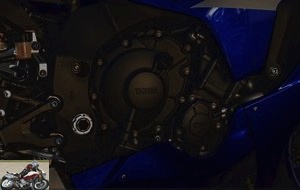 Yamaha YZF-R1 engine
Yamaha YZF-R1 engine
The intake is also changed and new Bosch injectors are now positioned above the 45mm diameter injection bodies. The air box retains its valve system. Closed at 7,500 rpm, it uses the entire volume to improve filling. Beyond that, the valve opens for a more direct passage to the intake ducts. Finally, the breath of the Yamaha boiler goes to a redesigned exhaust system with 4 catalysts; one pair located in front of the exhaust chamber and another pair at the rear. Above all, this allows us to be Euro5 approved…. without losing strength. This is transmitted to the wheel by a chain reinforced with thicker links.
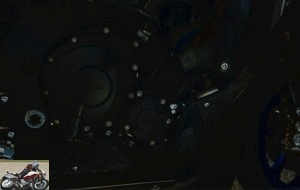 Yamaha YZF-R1M engine
Yamaha YZF-R1M engine
The geometry of the 2020 models is unchanged. Closed caster angle (24 °), 102 mm caster and 1,405 units wheelbase make up a lively and compact machine. The asymmetrical banana-type aluminum swing arm takes the load of the mechanics and entrusts its movements to a shock absorber optimized by new settings (in all directions). Under the control of a steering cylinder, the Kayaba 43 mm inverted fork also takes care of its operation on its 120 mm of travel. Pre-load, compression and relaxation adjust of course to your wishes. New damping valves combined with less spring calibration and a modified fork oil level optimize efficiency and feel. This in order to transmit to the pilot more precise information on the running surface..
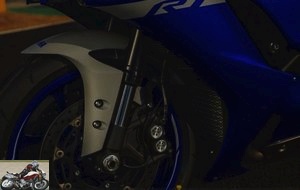 Yamaha YZF-R1 inverted fork
Yamaha YZF-R1 inverted fork
And control should also improve thanks to the new brake pads fitted to the monobloc radial calipers. Pushed by a radial master cylinder, their four pistons attack 320 mm discs. The dual piston rear clamp bites a 220mm disc. Everything is monitored by an ABS (BC) adjustable to 2 values, itself controlled by the inertial unit. To stick to the track, Bridgestone Battlax Racing Street RS11 (in 120/70 and 190/55) fit the 17-inch one-piece magnesium rims of the R1..
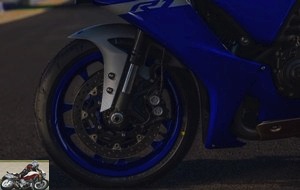 Front brakes of the Yamaha YZF-R1
Front brakes of the Yamaha YZF-R1
In its 2020 configuration, the tuning forks missile admits a slight increase in weight, passing all full facts to 201 kg.
Electronic
It is elsewhere and especially in electronics, as it is now customary, to look for the main differences with the old album. For the less computer-savvy, go to the On the saddle section.
For others, we start slowly with the Ride-by-Wire APSG throttle grip. A new magnet / sensor device transmits its signals to the YCC-T (inlet valve control). The control is equipped with a spring, a slide and a specific gear to restore a realistic feeling.
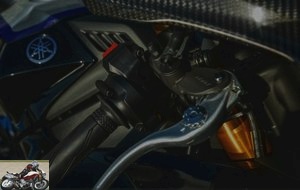 Yamaha YZF-R1M RBW Throttle
Yamaha YZF-R1M RBW Throttle
This is to better guide one of the four PWR injection maps (Power Mode / engine maps) selected. The first three provide the same nominal power and only influence the linearity of the throttle opening. Setting 4 is similar to a rain mode.
The Yamaha stud is of course under the yoke of a stream of chips. Main part of the system, a 6-axis inertial sensor unit (IMU) evaluates movements (forward, sideways and up and down) and gyroscopic movements (pitch, roll and yaw) in the three dimensions. By constantly analyzing this data taken 125 times per second, the IMU defines the position of the R1 and its behavior – including bank angle, slip and attitude changes. And it’s not for washing the dishes. No, this processor element reinforces, at any time, the 7 other assistances of the machine.
 Yamaha YZF-R1M speedometer
Yamaha YZF-R1M speedometer
We start with the new ABS braking control on the angle (BC) with now two modes. The first, BC1, offers constant ABS tuning, while the BC2 adjusts according to the lean angle and grip of the machine. In BC2 mode, ABS sensitivity increases as the lean angle increases. Note that the ABS cannot be disconnected.
 ABS adjustment on angle
ABS adjustment on angle
Another new electronic technology in the YZF-R1 is the Engine Brake Management (EBM) system, which now offers the rider the option of choosing from three levels of braking force (high-EBM1, medium, low-EBM3). Using data from various sensors including gear engaged, engine speed, throttle grip position, and throttle position, the ECU adjusts throttle opening, ignition timing and the injection volume to control the level of engine braking.
IMU requires, the traction control (TCS – Traction Control System) takes into account the angle of inclination of the machine. To modulate the power delivered, the electronic control unit acts on three parameters: the intake throttles, ignition and injection. The TCS is adjustable from 1 to 9 and can also be disconnected.
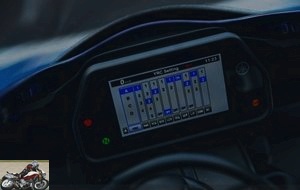 Choice of driving mode
Choice of driving mode
How about sliding around a corner or when braking on an angle? No worries, the SCS (Slide Control System). First used on the M1 Grand Prix in 2012, the SCS, exclusive to the R1, is interconnected with the TCS. Intended to limit sudden losses of grip or an excessive rotation differential between the front wheel and the rear wheel, it is supposed to allow moderate slip during acceleration. Adjustable on 3 levels, it can also be disconnected.
LIF (Active wheeling control). Adjustable on 3 levels or disconnectable, the LIF is not intended to limit wheeling beyond a certain angle, but rather to slow down the speed (or the brutality) of the pitching in order to make the latter more controllable..
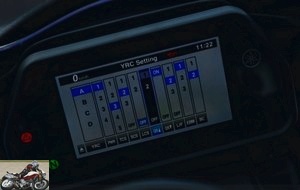 Quickshifter setting
Quickshifter setting
QSS (Quick Shift System – 2 settings + off) up and down. The shifter automatically cuts off the ignition in order to shift a gear “on the fly” without actuating the clutch. Adjustable on two levels, its action is electronically adjusted according to the engine speed, the gear engaged, the opening of the accelerator and the speed of the rear wheel.
The YZF-R1’s starting assistance (LCS) is proving even more effective for 2020. LCS1 mode has been changed to activate at 9000 rpm.
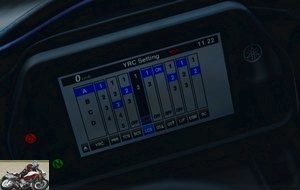 Setting the LCS departure assistant
Setting the LCS departure assistant
YZF-R1 M version
To the improvements already listed on the standard version, the M version adds even more performance and care. Tank and swingarm are polished and its (almost) all-carbon dress is eye-catching. But above all, it’s its golden front end that will swell your pride (and note). This 43mm Ohlins ERS NPX fork is pressurized! This is to limit possible cavitation. A neutral gas (nitrogen) ensures the pressure without weakening. And of course, compression on the left, rebound on the right are controlled by electronics on the dashboard.
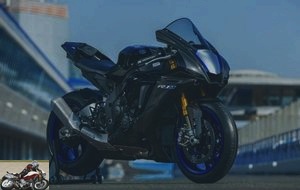 Yamaha YZF-R1M 2020
Yamaha YZF-R1M 2020
The critters with printed circuits also invest a specific box composing a data acquisition unit in connection with a central communication and Y-TRAC and YRC applications. This definitely directs the YZF-R1 M towards sustained running use. A dedicated 200 mm tire reinforces traction. The weight increases to 202 kg. Finally, each M model is numbered.
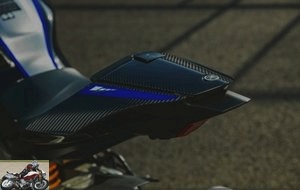 Yamaha YZF-R1M seat shell
Yamaha YZF-R1M seat shell
In the saddle
The standard YZF welcomes you 855mm from the ground. The M version peaks 5 units higher. Compact, narrow, the Yam ’exudes performance. From the outset, the available space is sensitive and the possible setback astonishing, making it possible to easily accommodate the taller people. The ergonomics are up to sporting standards, frankly tilting the bust towards fairly open half-handlebars. On rather long footrests, the feet find excellent support. Finally, the sculpted volumes of the tank give good latitude of movement..
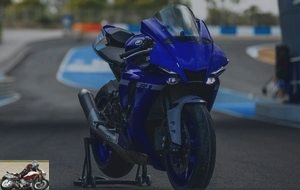 Yamaha YZF-R1
Yamaha YZF-R1
Unacceptable fault, the cable clutch control is not adjustable in spacing! A shame for this type of superlative machine. A choice shared by other brands. Fortunately, the brake lever is adjustable.
No big news on the beautiful TFT screen with two different interfaces: road or track. In “Road” mode, the tachometer, odometer, trip odometer, gear engaged, ambient and engine temperature, fuel consumption in real time, average and quantity of fuel consumed are displayed. The bargraph tachometer uses different colors depending on the engine speed.
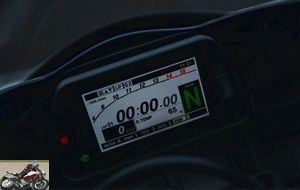 Yamaha YZF-R1 instrumentation
Yamaha YZF-R1 instrumentation
The icons at the top and bottom of the screen provide information on the activation of the TCS and SCS systems and the power mode selected. Two new icons appear logically: BC and EBM. On the right side, graduations materialize the pressure applied to the brake lever and the crushing of the front and rear suspensions. And the R1 does not forget to tell the time.
In "Track" mode, the one we will be using, the screen displays the number of laps completed, the lap time and the stopwatch function. Add to that the average fuel consumption and engine temperature. Specifically, the tachometer display starts at 8,000 revolutions and extends to the red zone. The gear engaged indicator is displayed on the right of the table.
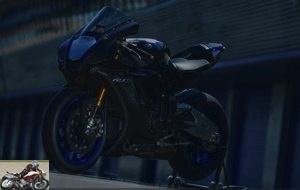 Yamaha YZF-R1M
Yamaha YZF-R1M
Also, four modes (A, B, C and D) allow programming of typical profiles. They include the desired mapping and the level of intervention of TCS, SCS and EBM (traction control, slip control and engine brake. LIF and QSS are unfortunately to be found in the less obvious menus via the right stalk and its wheel.
Finally, it will not be easy to change these settings intuitively while racing, the indications being quite small and the process lacking obvious..
On track
After this static study, it’s finally time to take the YZF for a few laps of the Iberian carousel. Its route of 4.428 km and 13 turns (8 to the right, 5 to the left) creates a technical appearance, fast in the curve with strong braking. What to highlight mechanics, chassis and cycle part. For our test, the standard R1 is offered to us for three 20-minute sessions. The tire fitment differs from the standard one because Battlax R11s, even more sporty, equip our mounts. Then comes the turn of the M version with slick Battlax V02 envelopes.
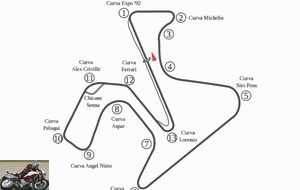 The layout of the circuito of Jerez Angel Nieto
The layout of the circuito of Jerez Angel Nieto
The Yamaha high-speed spaceship wakes up with a lot of restraint, Euro5 standards oblige. Rest assured, higher in the towers, the roaring chants of the cross-plane are much more audible.
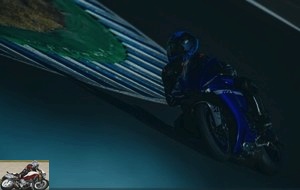 Test of the Yamaha YZF-R1 on the track
Test of the Yamaha YZF-R1 on the track
A short warm-up lap and we are already attacking the track more boldly. The first notable point of the R1 is its ease of handling. In a short time and whatever your level, the machine seems to you known and extremely tolerant. Agility is one of the key words of the Japanese. A constant that we particularly appreciate in the "Michelin Curva" which precedes the number 3 turn. This sequence highlights the precision of the chassis and its neutrality. Just as naturally, the four-cylinder catapults sportswomen towards the two biggest fast curves of the circuit. Engine availability is remarkable, allowing easy use of three and fourth gears over a large portion of the circuit. Of course, for more efficiency, we will use others, but the torque widely present from 8,000 revs energizes the R1 with force. And when the power takes over, the 200 horsepower sweeps the Yamaha off to the assault on the "Curva Sito Pons". Full angle, the R1’s stability is flawless and the trajectory control excellent. On relaunches, the airbox vibrates the air, conjuring its melody to that of the exhaust. The electronics then worked at full speed, torturing the tires which left long commas of gum as witnesses. Not enough to shake Michael van der Mark who passes me outside as if he had a title at stake.
 Driver of the manufacturer in WSBK, Michael Van Der Mark accompanied us on the track
Driver of the manufacturer in WSBK, Michael Van Der Mark accompanied us on the track
Under engine load, the front axle moves but the steering damper is on standby. While the anti-wheelie puts the steer wheel back to the ground quickly, the machine pulls into the rear on go-around and the anti-skid control controls tire drift. Here again, the implementation of assistance is very neutral. The efficiency is remarkable, without ever having too sensitive an intrusion.
 Yamaha YZF-R1 review with Michael van der Mark
Yamaha YZF-R1 review with Michael van der Mark
In the longest straight line of the circuit, we take advantage of the protection offered by the machine: to the significant setback in the saddle is added the upper deflection offered by the screen and the increased width of the front face. We won’t make a GT, but that’s a real plus for such a narrow machine. Still, it’s time to slow down. Powerful, the calliper attack is straightforward but deceleration is perfectly controllable with the lever. With one finger, the pressure is then modulated with a very good feeling throughout the braking. The gears stack without throbbing the load-absorbing limited-slip clutch. In a perfectly controlled dive, the machine barely moves from behind on the strongest decelerations. The ABS coupled with the inertial unit allows the brakes to be held on the corner for a long time in the "Curva Dry Bag". And when you release, no parasitic movement disturbs the steering. The bike stays precisely on course, without getting up or changing pitch violently. My driving is satisfied with a strong engine brake. Also, starting in mode 2, the EBM cuts out quite suddenly, leaving me a little surprised in the turn. I prefer to ensure while maintaining a greater feeling of the mechanics. Hey, Alex Lowes does not seem to ask a question, him ….
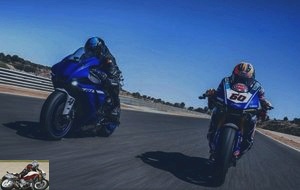 The 2020 R1 in a straight line
The 2020 R1 in a straight line
What to approach calmly, him and me, a technical sector, in particular the Curva Aspar, large fast curve with strong support. Finely guided by a precise throttle grip, the mechanics are smooth. A little more abrupt in PWR1 mode the electronics give a more progressive response in PWR2. The accelerator seems "linked to the rear wheel" as the stimuli are obvious to dose or the throttle to maintain in bends.
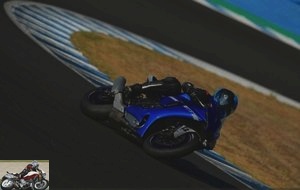 Review of the Yamaha YZF-R1 in Jerez
Review of the Yamaha YZF-R1 in Jerez
We then investigate two slower curves, "Curva Angle Nieto" and "Curva Peluqui" to appreciate the agility of the machine, the precision of its front axle and the rigidity of its chassis. On all occasions, the YZF-R1 also provides very good steering train feedback. Optimistic curve entry or strong downforce is retransmitted to the pilot without an overly sensitive filter. Guided by the eye, the Yam ’obeys the slightest pressure on the handlebars and footrests and takes you to the next turn.
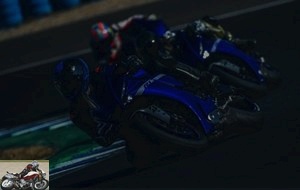 The Yamaha YZF-R1 on the corner
The Yamaha YZF-R1 on the corner
In this case, it was two quick breaks, the "Alex Criville" and "Ferrari" bends, where the CP4 titanium and steel stud broke him. As the exhaust twists the air, skimming the ground, I look for the most direct course to the final "Lorenzo" turn, the pin controlling the pit straight. We then pass the 1, or not…. when the shifter leaves you at a standstill. I will experience this surprise three times, always the same way. Too bad, because in general, its operation is very correct both uphill and downhill. But coupled with a box a little rough, the pedal requires a frank and direct movement. A house tradition will say the mauve tongues. Nothing to dwell on. We go to the "saucer" dominating the track for another easy round of pleasure.
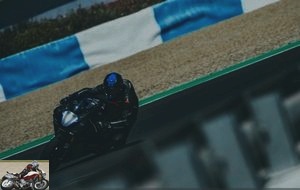 Test of the Yamaha YZF-R1M on the track
Test of the Yamaha YZF-R1M on the track
So what about the R1-M? Take the same frame of chassis excellence and add even more ease, control and performance to it. On board, the trajectories are more precise, the stability reaches new heights, the revivals do not compress the machine in any way and the road feel is velvet. And always with a lot of information. But above all and for the first time in my opinion, piloted suspensions are at the level of the very best purely mechanical achievements. With the first quality of a predictable behavior at every turn, every support, unlike the competition with processors. The confidence / efficiency capital is then clearly on the rise when your lap times are reduced..
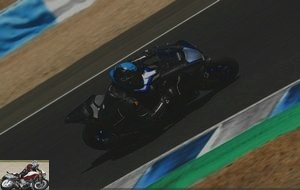 Review of the Yamaha YZF-R1M in Jerez
Review of the Yamaha YZF-R1M in Jerez
Here Ohlins offers ultra-high-end elements that perform well and, another advantage, are extremely easy to adjust. No tools, clicks, "tedious" reset. It all happens on the dashboard and if you get confused it is easy to revert to the default settings. As for the racing modules, the more athletic will appreciate the serial data acquisition and associated settings. Subtleties we haven’t had time to appreciate. However, I will qualify this overall assessment by the fact that the standard version was not on slick tires. The difference in feelings might be smaller.
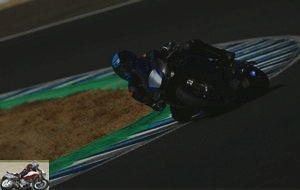 The Yamaha YZF-R1M on the corner
The Yamaha YZF-R1M on the corner
Conclusion
Ever more efficient developments, the Yamaha YZF-R1 and R1-M are refining their chassis behavior under the action of ever more efficient and almost imperceptible electronic assistance. Optimized, the mechanics seduce by its availability, its unabashed efficiency and its original character. The M version places the sporty tuning fork in the category of competition machines. Its surperlative suspensions combined with even more advanced electronics give you access to the next level, the big leagues, the ultimate class of customer competition. Accessible from € 19,299, the YZF-R1 relies on its ease and general efficiency to make you fall for it. Even more efficient, the M version will require € 25,999 to reach your garage. (A respective increase of 300 and 2,000 €)
 Yamaha YZF-R1 and R1M
Yamaha YZF-R1 and R1M
What to expect from rim closes ever more sharp and technological competition. Starting with the new RSV4 1100 Factory, a real production superbike, priced at € 22,999. No chip suspensions but high-end material. It comes with an almost unchanged twin, the RSV4 RR, at € 16,999.
Another opponent, the thunderous Ducati V4 is demanding at least € 22,790 to take up residence in your garage. Ease is not its primary quality. Another essential European, the BMW S1000RR appears at 19,200 €. At Suzuki, the powerful GSX-R 1000 is available for € 16,599, the GSX-R 1000R version requires € 19,399.
Obvious, stylish and powerful, boosted by a machine with a seductive personality, the Yamaha YZF-R1 and R1-M perpetuates the history of 20 years of excellence.
YZF-R1 strengths
- Original aesthetics
- Mechanical personality
- Precision and liveliness of the cycle part
- General ergonomics
- Quality of suspensions
- Efficient electronic assistance
- Flawless brakes and ABS
- Sound
- Quality of finishes
- Overall dynamic efficiency
- Pleasant instrumentation
Weak points YZF-R1
- Quickshifter up and down not always exemplary
- Rough box
- Adjustment of assistance while driving
Strengths YZF-R1M
- Same as YZF-R1
- Premium finish
- Bluffing electronic suspensions
Weak points YZF-R1M
- Same as YZF-R1
- Elite rate
The technical sheet of the Yamaha YZF-R1
The technical sheet of the Yamaha YZF-R1M
Test conditions
- Itinerary: Circuito de Jerez – Angel Nieto
- Weather forecast: sunny, 22 to 32 ° C
- Motorcycle mileage: 100 km
- Problem encountered: RAS
Test equipment
- Full face helmet Scorpion Exo R1-Air
- Vanucci Speed Profi IV Gloves
- Dainese Laguna Seca suit
- Dainese Torque D1 Boots
Related articles
-
A tri-wheeler called pleasure Three cylinders, 4T, 84.6 kW (115.0 hp), 87.5 N.m (8.9 m.kgf), 263 kg, 14,999 euros With the arrival in 2006 of the MP3…
-
The way to serenity 847 cc CP3 engine, 115 hp and 87.5 Nm, steered multi-axles, 267 kg full made, € 16,299 Since 2006, the Piaggio MP3 has masterfully…
-
Yamaha Tracer 9 and Tracer 9 GT motorcycle test
Cross-country sprinters 3 cylinders in line, 889 cm3, 119 hp and 93 Nm, 213 kg full made, from 11,499 euros Road trail, sport-touring, road … the names…
-
200 hp at 13,500 rpm, 112 N.m at 11,500 rpm, 199 kilos with full fuel, from € 18,499 Is the Crossplane engine an advantage in road use ? Even if the…
-
Test Yamaha XT 1200 ZE Super Tenere
E. character slipper XT …, Tenere … some legends can be found in a few signs. In this case, that of Yamaha trails. Driven by the greatest rally…
-
Yamaha MT-07 2021 motorcycle test
Generic anti-depressant Twin CP2, 689 cm3, 73.4 hp, 67 Nm, 184 kg, 7,299 euros The face of bikers in the medium-displacement segment, the Yamaha MT-07…
-
KTM 790 Adventure and Adventure R motorcycle comparison test
New icon, Easy Adventure 95 hp at 8,000 rpm and 89 Nm at 6,600 rpm KTM, it was the master of the single cylinder, then of the maxi trail but was absent…
-
Small (Force of) strike ! Unchanged since 2010, the Yamaha R6 remains a benchmark in the Supersports segment. Light and radical, it is as pleasant on the…
-
Yamaha XV 1900 Midnight Star custom test
The timeless Elegant Like other Japanese manufacturers, Yamaha offers a range of low riding bikes available in 3 models (XVS 950 A, XVS 1300 A) of which…
-
Yamaha Fazer FZ8 motorcycle test
Ho-mo-gene! (finally) Poor Yamaha FZ-8. When it arrived on the market in 2010, the new mid-size roadster from the tuning forks firm had all the assets…